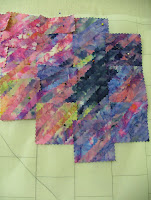Before I forget, I must remind local readers that Quiltfest (http://www.quiltfest.org.uk/)
is going to be held in Llangollen from February 1st – 12th. The guest quilter is
Ferret with her exhibition ‘Here Be Dragons’ staged in the International Pavilion.
In the museum, Magie Relph is showing her exhibition ‘Bucketful of Fabrics’
from 1st – 12th. I will follow Magie in the museum with my
‘Through the Garden Gate’ quilts from 13th February to March 7th.
The popular trading day is 12th February. Be there!
I have been creative this week, working on a river scene. After making the
Bluetit quilt a couple of weeks ago (it has yet to be quilted), I thought I
would like to step outside of the rigid discipline of making 3 ½” background
blocks. I decided instead to build up a picture using horizontal strips, just
to see how it looked. The starting point is the same as I have described
before, with a roughly drawn plan on baking parchment. I then trace the
features, in this case the rocks and foliage, onto a second piece of parchment
and work them independently. The picture shows the rocks in situ and the water
‘painted’.

Riverscape
I audition fabrics as I go along, and take pictures at each stage. This way I get
a good impression of how a fabric will fit in with the surrounding features
before I invest time in using it. Here I am considering whether I want a dark
or light horizon.
Ferret with her exhibition ‘Here Be Dragons’ staged in the International Pavilion.
In the museum, Magie Relph is showing her exhibition ‘Bucketful of Fabrics’
from 1st – 12th. I will follow Magie in the museum with my
‘Through the Garden Gate’ quilts from 13th February to March 7th.
The popular trading day is 12th February. Be there!
I have been creative this week, working on a river scene. After making the
Bluetit quilt a couple of weeks ago (it has yet to be quilted), I thought I
would like to step outside of the rigid discipline of making 3 ½” background
blocks. I decided instead to build up a picture using horizontal strips, just
to see how it looked. The starting point is the same as I have described
before, with a roughly drawn plan on baking parchment. I then trace the
features, in this case the rocks and foliage, onto a second piece of parchment
and work them independently. The picture shows the rocks in situ and the water
‘painted’.

Riverscape
I audition fabrics as I go along, and take pictures at each stage. This way I get
a good impression of how a fabric will fit in with the surrounding features
before I invest time in using it. Here I am considering whether I want a dark
or light horizon.
Auditioning fabrics
I chose the lighter version
and this is the story so far, with only the foliage to go. The machine quilting
is quietly piling up now so I will need to have a few sessions on that discipline
before too long.

Work in progress
The other project that has
been developed during the January sewing session at the Gresford craft group is
the log cabin bag, last mentioned in Blog 78, before Christmas got in the way.
The quilted sections are
ready to be joined together and the best way to illustrate this is with a
diagram. Lay the sections out and sew the base of the bag as shown below. Stop
sewing ¼” from the outer edge with a back stitch; this allows for the seam to
be manipulated at the corners in order to sew up the sides.
Sewing the Base
The lining is sewn in the
same way, using the template pictured in Blog 73. I will complete this project
next week.
Just a thought: Here I am, feeling like Dilly no-mates! There are 13 regular followers
of my blog and they have been ‘registered’ for some time. Now I know from
meeting other quilters that there are many more of you out there who drop in from
time to time. It has always been very specific to my quilting exploits and I am
happy to answer questions that arise from it. All I am asking is that more of
you register as followers so I feel as though I’m not talking to myself every
week!






































